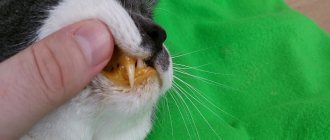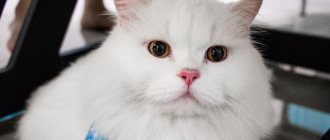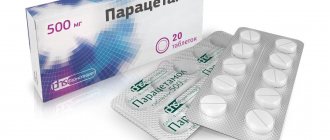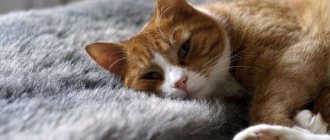Causes
Cats' sense of smell is much more sensitive than humans' - at least 14 times more sensitive. Therefore, inflammation in the nose area is more dangerous for pets than for people. The pathology also leads to breathing problems and the first symptom is a runny nose with discharge. The causes of the pathology are infectious pathogens and allergic reactions. The disease can be caused by a cold or severe frost.
The main causes of inflammation:
- getting wet (in the rain, while swimming);
- periodic hypothermia;
- skull injuries;
- bacterial infection of the nasopharynx;
- pneumonia;
- impaired immunity;
- burns of mucous membranes;
- calicivirus;
- viral diseases;
- tumors in the nasal cavity;
- sudden changes in temperature;
- caries;
- frostbite of mucous membranes;
- infectious peritonitis;
- excessive humidity in the house.
The cause may be chronic allergies, untreated colds, or unfinished course of antibiotic treatment. Inflammation in the oral cavity, pulpitis, and tartar can cause inflammation.
However, the main reason lies in pathogenic microbes. They enter the body through the nostrils or through the blood. After inflammation develops, the maxillary sinuses become filled with mucus and pus. The disease develops quickly as bacteria multiply rapidly. Ordinary snot is transformed into a caustic mass that droops through thin partitions.
Cat's House: all about cats
For animals, their sense of smell is extremely important. A cat's sense of smell is 14 times better than a human's. The animal has about 70 million olfactory cells. Cats distinguish odors not only through their nose, but also through their Jacobson tube. The organ is located on the upper palate.
Animals are especially sensitive to the content of nitrogen components, which allows them to recognize a spoiled product in the feed.
Procreation in cats depends on their sense of smell (the content of special substances in the urine of females attracts males).
In a cat, all diseases associated with loss of sense of smell cause her severe discomfort.
Symptoms
The pathology is accompanied by symptoms similar to those in humans. The pet begins to cough, sneeze, and have mucous or purulent discharge from the nose. At the same time, appetite decreases, weakness and loss of strength are observed. Body temperature rises significantly. The mucous membranes of the eyes turn red, the cat constantly rubs its nose with its paws.
The first signs include an increase in the cat's temperature by 1-3 degrees 1-2 days after suffering from a cold. The cat tries not to move its head, turning its body completely to survey the territory. Vision is impaired. Sinusitis can cause additional symptoms such as ear pain.
The appetite may disappear completely or the pet begins to be picky. For example, there is only warm or liquid food. Refusal from dry food is explained by the fact that it hurts the cat to chew. Due to swelling of the mucous membranes at the onset of inflammation, snoring or snoring appears during sleep. This may be a sign of perforation of the nasal septum.
Discharge from the sinuses is initially clear. Then they become white, and over time they turn yellowish (due to pus). With severe swelling of the mucous membrane, swelling of the throat develops. The progression of the disease is accompanied by a constant increase in temperature. However, only a veterinarian can determine the pathology, since cats have very “plastic” thermoregulation. Temperature can change even in a healthy pet. Only this sign does not always indicate sinus inflammation.
Diagnostics
First, an external examination of the cat is carried out. The veterinarian listens to the owner’s complaints and clarifies how long ago the symptoms of the disease appeared. The cat's temperature is then taken. However, a diagnosis cannot be made solely on the basis of its increase. Additionally, an x-ray is taken.
To identify the cause that caused inflammation and blockage of mucus and pus in the sinuses, a swab is taken from the oral cavity. To correctly prescribe treatment, the cat is weighed and its blood is taken for a general analysis. If the pet is more than seven years old, then the cat’s urine must be tested for testing, since swelling of the mucous membranes can be caused by impaired kidney function.
If antibiotic treatment is proposed, the sensitivity of pathogenic organisms to certain drugs is determined. This helps to choose the right drug, without experiments that can cause allergies in the cat.
Diagnostic measures
If a person suspects that a cat has developed sinusitis, it is important not to delay a visit to the veterinarian. At the appointment, the doctor will interview the animal’s owners and find out how long ago the unpleasant symptoms developed. Then the doctor will examine the pet and measure body temperature. To confirm the preliminary diagnosis, the cat is sent for radiography. To identify what caused the sinusitis, an oral rinse may be prescribed. To prescribe the correct therapeutic course, the pet is also sent for a general blood test.
If the pet is over 7 years old, a biological fluid test is required. Veterinarians explain this measure by the fact that swelling of the mucous membranes sometimes causes kidney problems.
Treatment
First, a mandatory x-ray is performed. On it, the maxillary sinuses look like dark spots, and the affected area is clearly visible.
Further treatment depends on the spread and stage of inflammation:
- When the sinuses are filled with pus or fluid, this causes increased pressure. To clear the cavities of contents, a puncture is made with a special thin needle and the mucus is pumped out with a syringe. The density of the liquid cannot be determined from the photographs. If it cannot be removed with a syringe, suction is performed.
- Medicines are prescribed depending on the cause of the pathology. To eliminate the infection and prevent further spread, antibiotics or antiviral agents are selected. The drugs are prescribed first in minimal doses, with caution. If the cat does not have a negative reaction, treatment continues.
- At home, owners should rinse their pet’s nostrils with an alcohol tincture of propolis if the sinusitis is of a viral nature.
- Additionally, the sinuses are treated with sea buckthorn or oxolinic ointment, calendula oil.
- St. John's wort infusion is used for rinsing if the disease is caused by pathogenic microorganisms.
- Warming compresses are applied to the nose.
- Additionally, drops are prescribed. If it is not possible to consult a veterinarian or come to an appointment, then 0.1 percent “Furacilin” or “Maxidin” is instilled into the nostrils (a drop per nostril) twice or thrice a day.
- Intramuscular administration of antibacterial agents or sulfonamides may be prescribed.
- The owner needs to clean the cat's nose several times daily with cotton swabs to remove secretions and prevent the formation of a crust.
- If possible, your pet should be taken to UHF sessions.
Sinusitis in a cat
Sinusitis is observed quite often in cats. The disease is an inflammatory process of the mucous membrane of the maxillary sinus.
Mostly, the pathology develops when an infection enters the nasal cavity. This is often observed when caries occurs.
Sinusitis is a serious disease that can cause a number of complications, and therefore requires mandatory therapy.
Why is it developing?
Mostly, sinusitis is diagnosed in cats after suffering infectious diseases. An unpleasant disease can also be caused by allergic reactions. In addition, the following factors cause sinusitis in cats:
- systematic hypothermia;
- getting wet;
- serious temperature changes;
- impaired immunity;
- high humidity in the room where the pet is kept;
- viral pathologies;
- traumatic injuries to the skull;
- mucosal burns;
- caries;
- bacterial infection of the sinuses.
What symptoms will indicate the disease?
With this disease, the animal may rub its nose with its paw.
As in humans, sinusitis in cats manifests itself with similar symptoms. The pathology is characterized by the following symptoms:
- cough;
- constant rubbing of the nose with paws;
- sneezing;
- weakness;
- drowsiness;
- loss of appetite;
- increased body temperature;
- mucous and purulent discharge from the sinuses;
- redness of the mucous membrane of the eyes.
Diagnostic measures
If a person suspects that a cat has developed sinusitis, it is important not to delay a visit to the veterinarian. At the appointment, the doctor will interview the animal’s owners and find out how long ago the unpleasant symptoms developed.
Then the doctor will examine the pet and measure body temperature. To confirm the preliminary diagnosis, the cat is sent for radiography. To identify what caused the sinusitis, an oral rinse may be prescribed.
To prescribe the correct therapeutic course, the pet is also sent for a general blood test.
If the pet is over 7 years old, a biological fluid test is required. Veterinarians explain this measure by the fact that swelling of the mucous membranes sometimes causes kidney problems.
How is the treatment carried out?
The method of treating the pet is determined by the veterinarian.
After undergoing diagnostic measures, the X-ray image shows dark sinuses filled with pus. Treatment of the disease is directly related to the scale of spread of pathogenic bacteria.
If the nasal cavity is completely filled with purulent discharge and causes increased pressure, the veterinarian makes a puncture and sucks out the mucus. However, this treatment of sinusitis in cats is not always effective, since radiography does not provide an understanding of how thick the nasal discharge is.
It is not possible to remove excessively dense pus using suction.
If frontal sinusitis in cats is diagnosed at the initial stages of development, the chances of successful treatment are much greater. Often they resort to intramuscular administration of sulfonamides or antibacterial medications.
Instillation of a medication called “Maxidin” or “Furacilin” may also be prescribed.
The owner will definitely need to carefully clean the nasal passages with a cotton swab from crusts and accumulated secretions at home.
In some situations, the application of oxolinic ointment is prescribed. If the disease is caused by pathogenic microorganisms, a tincture of St. John's wort is prescribed. Using it, you will need to rinse the animal’s nose to kill the bacteria.
When rhinosinusitis is of viral origin, they resort to propolis tincture, which is prepared on the basis of alcohol. Regeneration of affected nasal mucous membranes is achieved by using calendula ointment, as well as sea buckthorn oil.
If possible, your pet should be taken for UHF therapy.
Are there complications?
Chronic disease in a cat can lead to frequent sore throats.
When frontal sinusitis and sinusitis in cats are not treated in a timely manner, the disease becomes chronic. In such a situation, it acts as a source of infection, which becomes the cause of the systematic occurrence of pharyngitis and sore throat.
The development of various pathologies of the oral cavity, for example, osteomyelitis, is also possible. This disease is characterized by inflammation of the bones and bone marrow. The disease is considered one of the most dangerous. In addition, certain pathogens that provoke sinusitis in cats cause infectious peritonitis. The development of leukemia is also possible.
An abscess is often a consequence of sinusitis.
Preventive actions
To prevent this disease from occurring in cats, it is important to carefully care for your pets. In the room where the pet is kept, it is necessary to maintain an acceptable temperature, which should not be excessively high or low.
It is not recommended to bathe a cat during the cold season, especially if there is no heating in the apartment. The animal should be systematically given vitamins that will reduce the risk of disruption of the immune system.
As veterinarians from the Vetmaster veterinary clinic note, it is important not to self-medicate your cat and, if you suspect this dangerous disease, immediately contact a specialized medical facility.
Source: https://InfoKotiki.ru/zabolevania/infektsii/gaymorit-u-koshek.html
Prevention
To prevent illness in cats, pets should be kept warm, without hypothermia or overheating. You should not bathe them in cold weather, especially when there is no heating in the room. The cat needs to be constantly given vitamin supplements to strengthen the immune system and prevent disruptions in the body’s defense system.
Sinusitis in cats is not a fatal, but dangerous disease that can be easily cured in the first stages. In advanced cases, long-term treatment may be required, including new pathologies caused by complications. The owner cannot select medications on his own; consultation and examination by a veterinarian is required.
Are there complications?
When frontal sinusitis and sinusitis in cats are not treated in a timely manner, the disease becomes chronic. In such a situation, it acts as a source of infection, which becomes the cause of the systematic occurrence of pharyngitis and sore throat. The development of various pathologies of the oral cavity, for example, osteomyelitis, is also possible. This disease is characterized by inflammation of the bones and bone marrow. The disease is considered one of the most dangerous. In addition, certain pathogens that provoke sinusitis in cats cause infectious peritonitis. The development of leukemia is also possible. An abscess is often a consequence of sinusitis.










